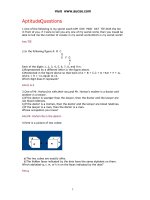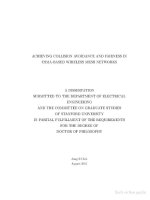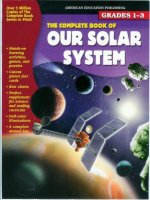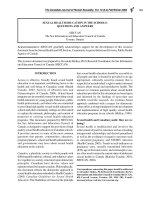Retrieving questions and answers in community based question answering services
Bạn đang xem bản rút gọn của tài liệu. Xem và tải ngay bản đầy đủ của tài liệu tại đây (1.01 MB, 156 trang )
RETRIEVING QUESTIONS AND ANSWERS
IN COMMUNITY-BASED
QUESTION ANSWERING SERVICES
KAI WANG
(B.ENG, NANYANG TECHNOLOGICAL UNIVERSITY)
A THESIS SUBMITTED
FOR THE DEGREE OF DOCTOR OF PHILOSOPHY
SCHOOL OF COMPUTING
NATIONAL UNIVERSITY OF SINGAPORE
2011
i
Acknowledgments
This dissertation would not have been possible without the support and guidance of
many people who contributed and extended their valuable assistance in the
preparation and completion of this study.
First and foremost, I would like to express my deepest gratitude to my advisor, Prof.
Tat-Seng Chua, who led me through the four years of PH.D study and research. His
perpetual enthusiasm, valuable insights, and unconventional vision in research had
consistently motivated me to explore my work in the area of information retrieval. He
offered me not only invaluable academic guidance but also endless patience and care
throughout my daily life. As an exemplary mentor, his influence has been
undoubtedly beyond the research aspect of my life.
I am also grateful to my thesis committee members Min-Yan Kan, Wee-Sun Lee
and external examiners for their critical readings and giving constructive criticisms so
as to make the thesis as sound as possible.
The members of Lab for Media Search have contributed immensely to my personal
and professional during my PH.D pursuit. Many thanks also go to Hadi Amiri,
Jianxing Yu, Zhaoyan Ming, Chao Zhang, Xia Hu, Chao Zhou for their stimulating
discussions and enlightening suggestions on my work.
Last but not least, I wish to thank my entire extended family, especially my wife Le
Jin, for their unflagging love and unfailing support throughout my life. My gratitude
towards them is truly beyond words.
i
Table of Contents
CHAPTER 1 INTRODUCTION
1.1 Background 1
1.2 Motivation 3
1.3 Challenges 6
1.4 Strategies 8
1.5 Contributions 11
1.6 Guide to This Thesis 12
CHAPTER 2 LITERATURE REVIEW
2.1 Evolution of Question Answering 14
2.1.1 TREC-based Question Answering 14
2.1.2 Community-based Question Answering 17
2.2 Question Retrieval Models 20
2.2.1 FAQ Retrieval 20
2.2.2 Social QA Retrieval 22
2.3 Segmentation Models 25
2.3.1 Lexical Cohesion 25
2.3.2 Other Methods 27
2.4 Related Work 29
2.4.1 Previous Work on QA Retrieval 30
2.4.2 Boundary Detection for Segmentation 33
CHAPTER 3 SYNTACTIC TREE MATCHING
3.1 Overview 37
3.2 Background on Tree Kernel 38
3.3 Syntactic Tree Matching 40
3.3.1 Weighting Scheme of Tree Fragments 41
3.3.2 Measuring Node Matching Score 43
ii
3.3.3 Similarity Metrics 44
3.3.4 Robustness 45
3.4 Semantic-smoothed Matching 46
3.5 Experiments 49
3.5.1 Dataset 50
3.5.2 Retrieval Model 51
3.5.3 Performance Evaluation 52
3.5.4 Performance Variations to Grammatical Errors 55
3.5.5 Error Analysis 57
3.6 Summary 58
CHAPTER 4 QUESTION SEGMENTATION
4.1 Overview 60
4.2 Question Sentence Detection 63
4.2.1 Sequential Pattern Mining 64
4.2.2 Syntactic Shallow Pattern Mining 65
4.2.3 Learning the Classification Model 69
4.3 Multi-Sentence Question Segmentation 71
4.3.1 Building Graphs for Question Threads 72
4.3.2 Propagating the Closeness Scores 76
4.3.3 Segmentation-aided Retrieval 79
4.4 Experiments 81
4.4.1 Evaluation of Question Detection 81
4.4.2 Question Segmentation Accuracy 85
4.4.3 Direct Assessment via User Study 86
4.4.4 Evaluation on Question Retrieval with Segmentation Model 88
4.5 Summary 93
CHAPTER 5 ANSWER SEGMENTATION
5.1 Overview 94
5.2 Multi-Sentence Answer Segmentation 100
5.2.1 Building Graphs for Question-Answer Pairs 100
5.2.2 Score Propagation 108
5.2.3 Question Retrieval with Answer Segmentation 111
5.3 Experiments 113
iii
5.3.1 Answer Segmentation Accuracy 113
5.3.2 Answer Segmentation Evaluation via User Studies 115
5.3.3 Question Retrieval Performance with Answer Segmentation 117
5.4 Summary 123
CHAPTER 6 CONCLUSION
6.1 Contributions 125
6.1.1 Syntactic Tree Matching 125
6.1.2 Segmentation on Multi-sentence Questions and Answers 126
6.1.3 Integrated Community-based Question Answering System 127
6.2 Limitations of This Work 127
6.3 Recommendation 130
BIBLIOGRAPHY. 133
APPENDICES
A. Proof of Recursive Function M(r
1
,r
2
) 144
B. The Selected List of Web Short-form Text 145
PUBLICATIONS 146
iv
List of Tables
Table 3.1: Statistics of dataset collected from Yahoo! Answers 51
Table 3.2: Example query questions from testing set 53
Table 3.3. MAP Performance on Different System Combinations and Top 1 Precision
Retrieval Results 53
Table 4.1: Number of lexical and syntactic patterns mined over different support and
confidence values 82
Table 4.2: Question detection performance over different sets of lexical patterns and
syntactic patterns 83
Table 4.3. Examples for sequential and syntactic patterns 84
Table 4.4: Performance comparisons for question detection on different system
combinations 85
Table 4.5: Segmentation accuracy on different numbers of sub-questions 86
Table 4.6: Performance of different systems measured by MAP, MRR, and P@1
(%chg shows the improvement as compared to BoW or STM baselines. All measures
achieve statistically significant improvement with t-test, p-value<0.05) 90
Table 5.1: Decomposed sub-questions and their corresponding sub-answer pieces 96
Table 5.2: Definitions of question types with examples 106
Table 5.3: Example of rules for determining the relatedness between answers and
question types 107
Table 5.4: Answer segmentation accuracy on different numbers of sub-questions 114
Table 5.5: Statistics for various cases of challenges in answer threads 114
Table 5.6: Performance of different systems measured by MAP, MRR, and P@1
(%chg shows the improvement as compared to BoW or STM baselines. All measures
achieve statistically significant improvement with t-test, p-value<0.05) 119
Table 6.1: An counterexample of "Best Answer" from Yahoo! Answers 129
v
List of Figures
Figure 1.1: A question thread example extracted from Yahoo! Answers 5
Figure 1.2: Sub-questions and sub-answers extracted from Yahoo! Answers 7
Figure 3.1: (a) The Syntactic Tree of the Question “How to lose weight?”. (b) Tree
Fragments of the Sub-tree covering "lose weight" 39
Figure 3.2: Example on Robustness by Weighting Scheme 46
Figure 3.3: Overview of Question Matching System 52
Figure 3.4: Illustration of Variations on a) MAP, b) P@1 to Grammatical Errors. 56
Figure 4.1: Example of multi-sentence questions extracted from Yahoo! Answers 61
Figure 4.2: An example of common syntactic patterns observed in two different
questions 66
Figure 4.3: Illustration of syntactic pattern extraction and generalization process 68
Figure 4.4: Illustration of one-class SVM classification with refinement of training
data (conceptual only). Three iterations (i) (ii) (iii) are presented 71
Figure 4.5: Illustration of the direction of score propagation 78
Figure 4.6: Retrieval framework with question segmentations 80
Figure 4.7: Score distribution of user evaluation for 3 systems 87
Figure 5.1: An example demonstrating multiple sub-questions and sub-answers 96
Figure 5.2: An example of answer segmentation and alignment of sub-QA pairs 98
Figure 5.3: Score distribution of user evaluation for two retrieval systems 116
i
Abstract
Question Answering endeavors in providing direct answers in response to user’s
questions. Traditional question answering systems tailored to TREC have made great
progress in recent years. However, these QA systems largely targeted on short, factoid
questions but overlooked other types of questions that commonly occur in the real
world. Most systems also simply focus on returning concise answers to the user
query, whereas the extracted answers may lack comprehensiveness. Such simplicity in
question types and limitation in answer comprehensiveness may fare poorly if end-
users have more complex information needs or anticipate more comprehensive
answers. To overcome such shortcomings, this thesis proposes to make use of
Community-based Question Answering (cQA) services to facilitate the information
seeking process given the availability of tremendous number of historical question
and answer pairs in the cQA archives on a wide range of topics. Such a system aims
to match the archived questions with the new user question and directly returns the
paired answers as the search result. It is capable of fulfilling the information need of
common users in the real world, where the user formed query question can be verbose,
elaborated with the context, while the answer should be comprehensive, explanatory
and informative.
However, utilizing the archived QA pairs to perform the information seeking
process is not trivial. In this work, I identify three major challenges in building up
such a QA system – (1) matching of complex online questions; (2) multi-sentence
questions mixed with context sentences; and (3) mixture of sub-answers
corresponding to sub-questions. To tackle these challenges, I focus my research in
ii
developing advanced techniques to deal with complicated matching issues and
segmentation problems for cQA questions and answers.
In particular, I propose the Syntactic Tree Matching (STM) model based on a
comprehensive tree weighing scheme to flexibly match cQA questions at the lexical
and syntactic levels. I further enhance the model with semantic features for additional
performance boosting. I experimentally show that the STM model elegantly handles
grammatical errors and greatly outperforms other conventional retrieval methods in
finding similar questions online.
To differentiate sub-questions of different topics and align them to the
corresponding context sentences, I model the question-context relations into a graph,
and implement a novel score propagation scheme to measure the relatedness score
between questions and contexts. The propagated scores are utilized to separate
different sub-questions and group contexts with their related sub-questions. The
experiments demonstrate that the question segmentation model produces satisfactory
results over cQA question threads, and it significantly boosts the performance of
question retrieval.
To perform answer segmentation, I examine the closeness relations between
different sub-answers and their corresponding sub-questions. I again adopt the graph-
based score propagation method to model their relations and quantify the closeness
scores. Specifically, I show that answer segmentation can be incorporated into the
question retrieval model to reinforce the question matching procedure. The user study
shows the effectiveness of the answer segmentation model in presenting user-friendly
results, and I further experimentally demonstrate that the question retrieval
performance is significantly augmented by combining both question and answer
segmentation.
The main contributions of this thesis are in developing the syntactic tree matching
model to flexibly match online questions coupled with various grammatical errors,
iii
and the segmentation models to sort out different sub-questions and sub-answers for
better and more precise cQA retrieval. Most importantly, these models are all generic
such that they can be applied to other related applications.
The major focus of this thesis lies in the judicious use of natural language
processing and segmentation techniques to perform retrieval for cQA questions and
answers more precisely. Apart from the use of these techniques, there are also other
components with which a desirable cQA system should possess, such as answer
quality estimation and user profile modeling etc. These modules are not included in
the cQA system as derived from this work because they are beyond the scope of this
thesis. However, such integration will be carried out in the future.
1
Chapter 1 Introduction
1.1 Background
The World Wide Web (WWW) has grown to a tremendous knowledge repository
with the blooming of Internet. Based on the estimation of the numbers of indexed
Web pages by various search engines such as Google, Bing and Yahoo! Search, the
size of WWW is reported to have reached to size of 10 billion in October 2010 [3].
The wealth of enormous information on the Web makes it an attractive resource for
human to seek information. However, to find valuable information from such a huge
library without proper tool is not easy, as it is like looking for a needle in a haystack.
To meet such huge information need, search engines have risen into people’s view
due to their strong capability in rapidly locating relevant information according to
user’s queries.
While Web search engines have made important strides in recent years, the problem
of efficiently locating information on the Web is still far from being solved. Instead of
directly advising end-users of the ultimate answer, traditional search engines
primarily return a list of potential matches, whereas the users still need to browse
through the result list to obtain what they want. In addition, current search engines
simply take in a list of keywords that better describe user’s information need, rather
2
than handling a user question posted in natural language. These limitations not only
hinder the user from obtaining the most direct answers from the Web, but also
introduce an overhead of converting natural language query into a list of keywords.
To addresses this problem, a technology named Question Answering (QA) begins to
dominate the researcher’s attention in recent years. As opposed to Information
Retrieval (IR), QA is endeavored in providing direct answers to user questions by
consulting its knowledge base and it requires more advanced Natural Language
Processing (NLP) techniques.
Current QA research attempts to deal with a wide range of question types including
factoid, list, definition, how, why, hypothetical, semantically constrained, and cross-
lingual questions etc. For example, the question “What is the tallest mountain in the
world?” is a factoid question asking for certain facts about an object; the question
“Who, in the human history, have set foot on the moon?” is a list question that
potentially looks for a set of possible answers belonging to the same group; the
question “Who is Bill Gates?” is considered to be a definition question, for which any
interesting facets related to the target “Bill Gates” can become a part of the answer;
the question “How to lose weight?” is a how question asking for methodologies and
the question “Why is there salt in the ocean?” is a why question going after certain
reasons. In particular, the former three types of questions (i.e. factoid, list, definition)
have been extensively studied in the QA track of the Text Retrieval Conference
(TREC) [1], which is a highly recognized annual evaluation task of IR systems since
1990s.
Most of the state-of-the-art QA systems are tailored to TREC-QA. They are built
upon a document collection such as a news corpus aiming at answering factoid, list
and definitional questions. These systems have complex architectures, but most of
them are built on the basis of three basic components including question analysis
(query formulation), document/passage retrieval, and answer extraction. On top of
3
this framework, there have also been many techniques developed aiming to further
drive the QA systems to provide better answers. These techniques vary from lexical
based approaches to syntactic-semantic based approaches, with the use of external
knowledge repositories. They include statistical passage retrieval [96], question
typing [42], semantic parsing [30, 103], named entities analysis [73], dependency
relation parsing [94, 30], lexico-syntactic pattern parsing [10, 102], soft pattern
matching [25], usage of external resources such as WordNet [78, 36] and Wikipedia
[78, 106] etc. The combination of these advanced technologies has pushed the state-
of-the-art QA systems into the next level in providing satisfying answers to user’s
queries in terms of both precision and relevance. This kind of great success can also
be observed through the year-by-year TREC-QA tracks.
1.2 Motivation
While many systems tailored to TREC have been shown great successes in a series
of assessments during the last few years, two major weaknesses, however, have been
identified:
1. Limited question types – Most current QA systems largely targeted to factoid and
definitional questions but, whether intentionally or unintentionally, overlooked
other types of questions such as the why and how type questions. Answering these
non-factoid based questions is considered to be difficult, as the question and
answer can have very few overlaps, which imposes additional challenges to
answer extraction. Fukumoto [33] attempted to develop answer extraction patterns
using causal relations for non-factoid questions, but the performance is not high
due to the lack of indicative patterns. In addition, the factoid questions handled by
current QA systems are relatively short and simple, whereas the questions in the
real world are usually more complicated. I refer the complicate questions here as
ones complemented with various description sentences elaborating the context and
4
background of the posted questions. A desirable QA system should be capable of
handling various forms of real world questions and be aware of the context being
posted along with the questions.
2. Lacks of comprehensiveness in answers – Most systems simply look for concise
answers in response to a question. For example, TREC-QA simply expects the
year “1960” for the factoid question “In what year did Sir Edmund Hillary search
for Yeti?”. Although this scenario serves, to the greatest extent, the purpose of QA
by providing the most direct answer to the end-users without the need for them to
browse through a document, it brings one side effect to the QA applications
outside TREC [18]. In the real world, users sometimes prefer a longer and more
comprehensive answer rather than a simple word or phrase that contains no
context information at all. For example, when a user posts a question like “Is it
safe to use a 12 volt adapter for toy requiring 6 volts?”, he/she never simply
anticipates a “Yes” or “No” answer. Instead, he/she would prefer to find out the
reason of being either safe or unsafe.
In view of the above, I argue that while QA systems tailored to the TREC-QA task
worked relatively well for factoid-type questions in various evaluation tasks, they
indeed face the obstacles of being deployed into the real world.
With the blooming of Web 2.0, social collaborative applications such as Wikipedia,
YouTube, Facebook etc. begin to flourish, and there has been an increasing number of
Web information services that bring together a network of self-declared “experts” to
answer questions posted by other people. This is referred to as the community-based
question answering services (cQA). In these communities, anyone can ask and answer
questions on any topic, and people seeking information are connected to those who
know the answer. As the answers are usually explicitly provided by human and are
comprehensive enough, they can be helpful in answering the real world questions.
5
Yahoo! Answers
1
, launched by on July 5, 2005, is one of the largest knowledge-
sharing online communities among several popular cQA services. It allows online
users to not only submit questions to be answered but also answer questions asked by
other users. It also allows the user community to choose the best answer from a line-
up of candidate answers. The site also gives its members the chance to earn points as
a way to encourage participation.
Figure 1.1
demonstrates a snapshot of one question
thread discussed in Yahoo! Answers, where several key elements such as the posted
question, the best answer, the user ratings and the user voting etc. are presented.
Figure 1.1: A question thread example extracted from Yahoo! Answers
Over times, a tremendous number of historical QA pairs have been stored in the
Yahoo! Answers database. This large scale question and answer repository has
1
6
become an important information resource on the Web [104]. Instead of looking
through a list of potentially relevant webpages, user can directly obtain the answer by
searching for similar questions through the QA archive. Its criticism system also
ensures a high quality of the posted answer, where the chosen “best answer” can be
considered as the most accurate information in response to the user question. As such,
instead of looking for the answer snippets from a certain document corpus, the “best
answer” can be utilized to fulfill the user’s information need in a rapid way. Different
from traditional QA task, the retrieval task in cQA is to find the relevant similar
questions with the new query posted by the user and to retrieve its corresponding high
quality answers [45].
1.3 Challenges
As an alternative to the general QA and Web search, the cQA retrieval task has
several advantages over them [104]. First, the user can employ a natural language
instead of a set of keywords as a query, and thus can potentially present his/her
information need more clearly and comprehensively. Second, the system returns
several possible answers instead of a long list of ranked documents, and therefore can
increase the efficiency of locating the desired answers.
However, finding relevant similar questions in cQA is not trivial, and directly
utilizing the archived questions and answers can impose other side effects as well. In
particular, I have identified the following three major challenges in cQA:
1. Similar question matching – As users tend to post online questions freely and ask
questions in natural language, questions can be encoded with various lexical,
syntactic and semantic features, and it is common that two similar questions share
no similar words in common. For example, “how can I lose weight in a few
month?” and “are there any ways of losing pound in a short period?” are two
similar questions, but they neither share many similar words nor follow the
7
identical syntactic structure. This word mismatching problem makes the similar
question matching task more difficult, and it is desirable for the cQA question
retrieval to be aware of such semantic gap.
2. Mixture of sub-questions – Online questions can be very complex. It is observed
that many questions posted online can be very long, comprising multiple sub-
questions asking in various aspects. Furthermore, each sub-question can be
complemented with some description sentences elaborating its context as well.
Figure 1.2 exemplifies one such example. The asker posts two different sub-
questions together with some contexts in the question body (as underlined), where
one sub-question asks for the functionality of glasses and the other sub-question
asks for the outcome of wearing glasses. I believe that it is extremely important to
properly segment the question thread rather than considering it as a single unit.
Different sub-questions possess different purposes, and a mixture of them can lead
to a confusion in understanding the user’s different information needs, which can
further hinder the system from presenting the user the most appropriate fragments
that are relevant to his/her queries.
Qid
20101014171442AAmQd1S
Subject
How are glasses supposed to help your eyes?
Content
well i got glasses a few weeks back and I thought how are they supposed to help you. I
mean liike when i take them off everythings all blurry. How is it supposed to help your
eyes if your eyes constantly rely on your glasses for visual aid???? Am i supposed to
wear the glasses for the rest of my life since my eyes cant rely on themselves for clear
vision????
Best
Answer
Yes you will have to wear glasses for the rest of your life - I've had glasses since I was
10, however these days as well as surgery there is the option of contact lenses and
glasses are a lot better than they used to be. It isn't very nice to realize that your vision is
never going to be perfect without aids however it is sometihng which can be managed
and technology to help is now extremely good.
Glasses don't make your eyes either better or worse. They help compensate for teh fact
that you can't see properly without them. i.e things are blurry. The only way your eyes
will get better is surgery which is available when you are old enough ( you don't say
your age) and for certain conditions although there are risks.
Figure 1.2: Sub-questions and sub-answers extracted from Yahoo! Answers
8
3. Mixture of multiple sub-answers – As a posted question can include multiple sub-
questions, the answer in response to it can comprise multiple sub-answers as well.
As again illustrated by the example in Figure 1.2, the best answer consists of two
separate paragraphs answering two sub-questions respectively. In order to present
the end-user the most appropriate answer to a particular sub-question, it is
necessary to segment the answer thread and align each sub-answer with their
corresponding sub-questions. On top of that, it is also found that each sub-answer
might not strictly follow the posting order of the sub-questions. As exemplified by
the “best answer” in Figure 1.2, the first paragraph in fact responses to the second
sub-question, while the second paragraph answers the first sub-question. In
addition, it is also found that the sub-answers may not have the one-to-one
correspondence to the sub-questions, meaning that the answerer can neglect
certain parts of the questions by leaving it unanswered. Furthermore, the asker can
often post duplicate sub-questions as well. The question presented in the subject
part of Figure 1.2 (“How are glasses supposed to help your eyes?”) was in fact
repeated in the content. All these characteristics impose additional challenges to
the cQA retrieval task, and I believe they should be properly addressed to enhance
the answer retrieval performance.
1.4 Strategies
To tackle the abovementioned problems, I have proposed an integrated cQA
retrieval system that is supposed to deal with the matching issue of the cQA complex
questions and the segmentation challenges of the cQA questions and answers. In
contrast to traditional QA systems, the proposed system employs a question matching
model as a substitute of passage retrieval. For more efficient retrieval, the system
further performs the segmentation task on the archived questions and answers so as to
9
line up individual sub-questions and sub-answers. I sketch these models in this
Section and further detail them in Chapter 3, 4 and 5 respectively.
For the similar question finding problem, I have proposed a novel syntactic tree
matching (STM) approach [100], where the matching is performed on top of the
lexical level by considering not only the syntactic but also the semantic information. I
hypothesize that matching for the syntactic and semantic features can improve the
performance of the cQA question retrieval as compared to the systems that employ
only the matching at the lexical level. The STM model embodies a comprehensive
tree weighting scheme to not only give a faithful measure on question similarity, but
also handle grammatical errors gracefully.
In recognizing the problem of multiple sub-questions in cQA, I have extensively
studied the characteristics of the cQA questions and proposed a graph-based question
segmentation model [99]. This model separates question sentences from context (non-
question) sentences and aligns sub-questions with sub-answers according to the
closeness scores as leant through the constructed graph model. As a result, each
question thread is decomposed into several segments with the topically related
question and context sentences grouped together. These segments ultimately serve as
the basic units for the question retrieval.
I have further introduced an answer segmentation model for the answer part. The
answer segmentation is analogue to the question segmentation in the way that it
focuses on separating the answer thread with different topics instead of the question
thread. To tackle the challenges in the question-to-answer alignment task (e.g., the
repeated sub-questions and the partially answered questions), I have again applied the
graph based propagation model. In regards of the question-context and question-
answer relationships in cQA, the proposed graph model has several advantages over
other heuristic or clustering methods, and I will elaborate the reasons in Chapter 4 and
Chapter 5 respectively.
10
The evaluation of the proposed integrated cQA retrieval system is carried out in
three phases. I first evaluate the STM component and demonstrate that it outperforms
several traditional similarity matching methods. I next incorporate the matching
model with the question segmentation model (STM+RS), and show that the
segmented questions can give additional boosting to the cQA question retrieval
performance. By integrating the retrieval system with the answer segmentation model
(STM+RS+AS), I further illustrate that answer segmentation presents the answers to
the end-users in a more manifested way, and it can further improve the question
retrieval performance. In view of the above, I thereby put forward the argument that
syntactic tree matching, question segmentation and answer segmentation can
effectively address the three challenges that I have identified in Section 1.3.
The core components of the proposed cQA retrieval system leverage syntactic tree
matching and segmentations. Besides these components, other modules in the system
also impact the final output. These components include the technologies of question
analysis, question detection and question type identification etc. These technologies
however, will not be discussed in detail, as they are beyond the scope of this thesis.
Apart from the question matching model and the question/answer segmentation
model, there are also other components which I think are important to the overall cQA
retrieval task. They include (but are not limited to) the answer quality evaluation and
the user profile modeling. As answers posted online can be intermingled with both
high and low quality contents, it is necessary to provide an assessment tool to measure
such qualities for better answer representation. Answer quality evaluation aims at
assessing the answer quality based on available information including the textual
features like the text length and other non-textual features such as user profiles and
voting scores etc. Likewise, to evaluate the quality and reliability of the archived
questions and answers, it is also essential to quantitatively model the user profile
11
through factors such as user points, the number of questions resolved, and the number
of best answers given etc.
I believe that an ideal cQA retrieval system should also include these two
components to retrieve and present questions and answers more comprehensively.
The scope of this thesis however, more focuses on the precise retrieval of questions
and answers via the utilization of NLP and segmentation techniques. There also has
been work proposed in measuring the answer qualities and modeling the user profiles,
I therefore do not include them as a part of my research.
1.5 Contributions
In this thesis, I focus on more precise cQA retrieval, and make the following
contributions:
Syntactic Tree Matching. I present a generic sentence matching model for the
question retrieval task. Moreover, I propose a novel tree weighting scheme to
handle the grammatical errors as commonly observed in the online environment. I
evaluate the effectiveness of the syntactic tree matching model on the cQA question
retrieval task. The matching model can incorporate other semantic measures and can
be extended to other applications that involve the sentence similarity measure.
Question and Answer Segmentation. I propose a graph based propagation method to
segment multi-sentence questions and answers. I show how the question and answer
segmentation helps improve the performance of question and answer retrieval in a
cQA system. In particular, I incorporate user query segmentation and question
repository segmentation to the STM model to improve the question retrieval result.
Such a segmentation technique is also applicable to other retrieval systems that
involve the separation of multiple entities with different aspects.
Community-based Question Answering. I integrate the abovementioned two
contributory components into the cQA system. In contrast to traditional TREC-
12
based QA systems, such an integrated cQA system handles natural language queries
and answers a wide range of questions not limited to just factoid and definitional
questions. With the help of the question segmentation module, the proposed cQA
system better understands user’s different information needs and makes the
retrieving process more manageable, whereas the answer segmentation module
presents the answers in a more user-friendly manner.
1.6 Guide to This Thesis
The rest of the thesis is organized as follows:
In Chapter 2, I give a literature review on question answering in both the traditional
Question Answering and the Community-based Question Answering. In particular, I
will first give an overview of the existing QA architectures, and discuss the state-of-
the-art techniques, ranging from the statistical, the lexical, the syntactic, to the
semantic approaches. I will also present related work on Community-based Question
Answering from the perspective of the similar question matching and the multi-
sentence question segmentation etc.
Chapter 3 presents the Syntactic Tree Matching model. As the matching model is
inspired by the tree kernel model, a background introduction on the tree kernel
concept will be firstly given, and the architecture of our syntactical tree matching
model follows. I will also present an improved model with various semantic features
incorporated, and lastly show some experimental results. A short summary will be
provided in the end to this part of work.
Chapter 4 presents the proposed multi-sentence question segmentation model. I will
first present the proposed technique for question sentence detection and next describe
the detailed algorithm and architecture for multi-sentence segmentation. I will further
demonstrate an enhanced cQA question retrieval framework aided with question
13
segmentation. In the end, some experimental results will be shown, followed by a
directive summary with directions for its future work.
Chapter 5 presents the proposed methods for the answer segmentation model. I will
first illustrate some real world examples to demonstrate the necessity as well as the
challenges of performing the answer segmentation task. Next, I will describe the
proposed answer segmentation technique and also present an integrated cQA system
framework incorporated with both question segmentation and answer segmentation. I
will experimentally show that answer segmentation provide more user-friendly results
and improve the question retrieval performance in the end.
I conclude this thesis in Chapter 6. In summary, I will summarize the work and
point out the limitations of this work. In the end of the thesis, I present possible future
research directions.
14
Chapter 2 Literature Review
2.1 Evolution of Question Answering
Different from the traditional information retrieval [85] tasks that return a list of
relevant documents for a given query, the QA system aims to provide an exact answer
in response to a natural language question [67]. The types of questions in the QA
tasks generally comprise of factoid questions (questions that look for certain facts)
and other complex questions (opinion, “how” and “why” questions). For example, the
factoid question “Where was the first Kibbutz founded?” should be answered with the
place of foundation, whereas the complex question “How to clear cache in sending
new email?” should be responded with the detailed method to clear the cache.
2.1.1 TREC-based Question Answering
The QA evaluation campaigns such as TREC-QA have evolved for more than a
decade. The first TREC evaluation task in questions answering took place in 1999
[98], and the participants were asked to provide a text fragment of 50-bytes or 250-
bytes to some simple factoid questions. In TREC-2001 [97], list question (e.g. “Which
cities have Crip gangs?”) was introduced. The list question usually specified the
number of items to be retrieved and required the answer to be mined from several
documents. In addition to that, context questions (questions related to each other)
15
occurred as well, and the questions in the corpus were no more guaranteed to have an
answer in the collection. TREC-2003 further introduced definition questions (e.g.
“Who is Bill Gates?”), which combined the factoid and list questions into a single task.
From TREC-2004 onwards, each integrated task was associated with a topic, and
more constraints were introduced on the questions, including temporal constraints,
more anaphora and references to previous questions.
Although systems tailored to TREC-QA had made significant progress through the
year-by-year evaluation exercises, they largely focused on short and concise questions,
and more complex questions were generally less studied. Besides factoid, list and
definitional questions, there are other types of questions commonly occur in the real
world, including the ones concerning procedures (“how”), reasons (“why”) or
opinions etc. Different from the fact-based questions, the answers to these complex
questions may not locate in a single part of a document, and it is not uncommon that
the different pieces of answers are scattered in the collection of documents. A
desirable QA system thus should be capable of locating different sources of
information so as to compile a synthetic “answer” in a suitable way.
The Question-Answering track in TREC was last ran in 2007 [28]. In recent years,
TREC evaluations have led to some new tracks related to it, including the Blog Track
for seeking behaviors in the blogosphere and the Entity Track for performing entity-
related searches on Web data [67]. These new tracks led to some new evaluation
campaigns such as TAC (Text Analysis Conference)
2
, whose main purpose is to
accurately provide answers to complex questions from the Web (e.g. opinion
questions like “Why do people like Trader Joe’s?”) and to return different aspects of
the opinions (holder, target and support) with respect to a particular polarity [27].
Unlike TREC-QA, questions in the TAC task are more complicated, and they usually
expect more complex explanatory answers. However, the performance of opinion QA
2









